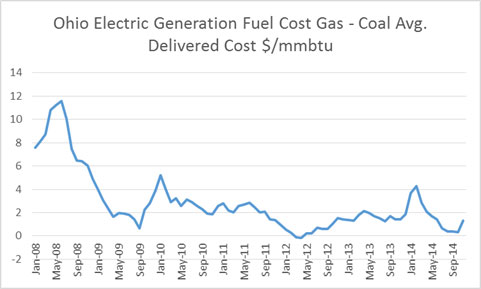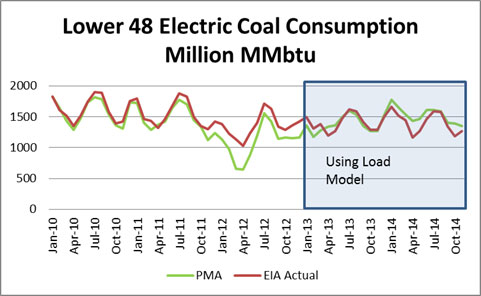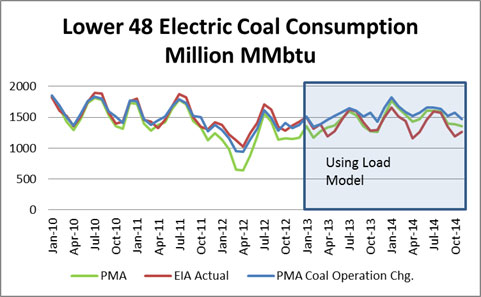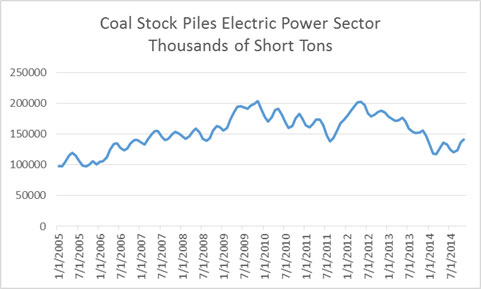Coal to Gas Switching – 2012 Déjà vu?

This report available in PDF Form.
The amount of gas and coal burns in the power markets go beyond simple economics when the price spread between gas and coal are very narrow as observed in 2012 – see figure below. Those attempting to use supply stacks or historical calculations will likely see incorrect numbers. When the price spread is high, those methods will work quite well, as long as the markets do not observe large retirements or new builds in the power fleet.
To demonstrate the issue with low gas to coal price spread, we present our calibration results of fuel burns over the last few years. Please note the 2012 discrepancy. One could conclude our models are fatally flawed.
However, the goal of PMA is to understand the markets and quantify the risk in the market place. The calibration run represents the default runs that we run forward in time in our BASE case. The key inputs, which drive the BASE case, are weather, economy, and commodity price. Two large areas not demonstrated in the base inputs are outages and utility operations. However, these are simulated in our risk runs that run daily with the BASE runs. The default outage profiles in the BASE case were developed based on a unit by unit investigation over a 5 year period. For the 2014 deviation, much of this can be attributed to outages which are captured in our risk cases. The winter deviation was discussed in our winter assessment. In addition, greater maintenance outage occurred in the shoulder months in 2014 as units have been installing FGD, SCR, and baghouses for the EPA regulations. The relevant issue for 2015 summer is how coal generators plan to operate and dispatch their plant. In the BASE case, utility operations are assumed to be market driven. However, in 2012, this is not what happened for several coal units.
To prove this, we re-ran the BASE case with modifying the market behavior of several coal units. Now the figure of coal consumption matches quite well in 2012.
The issue in 2012 which resulted in the need to change the operation mode of coal units was a result of the coal purchased in 2011. The futures market curve in 2011 for 2012 showed a much larger spread in gas and coal prices and also a robust power market price. This resulted in a much larger purchase of coal than required in the market place in 2012. This caused coal inventories to be very high- see figure below. This dynamic of coal purchasing was a result in the shift in coal and power markets – see our discussion on Coal Market Changes below.
Many plants cited hazardous conditions of stock piles resulting in the need to use the coal regardless of power plant economics. If this behavior did not occur, the trajectory of coal inventories would have gone much higher.
The reason not to adopt this method in the BASE case is the issue with power prices and the principle of market behavior being rationale over time. As expected, if the coal generators ran uneconomically, they would distort the price – see figure below. There is a Heisenberg Uncertainty Principle in power modeling. The volumes and price of the market cannot be discovered simultaneously in the same level of precision. As soon as you get your volumes correct your prices will be off. There is a give and take between those two. Given the model was developed for trading power prices and understanding the power market price risk – we prefer to be more accurate on prices than fuel burns. However we can adjust the settings for our clients need.
Most utilities still use the futures market as their guideline to purchasing. They should run multiple scenarios and situations using a platform like PMA to really understand the meaning of the futures market. The futures market clearly weighs the risk of near term events more than the actual possibilities. PMA can correctly quantify this risk, so you can make an educated decision on your fuel purchase. Not only can we quantify economy, weather, and commodity price risk, but we can quantify the other facets of the market place such as utility operations presented here.
Our 2015 summer assessment (May-Sept) shows if we applied the same utility modifications done in 2012 we can see an increase of coal consumption of 14% from our base case. The likelihood of this is less given the current coal stocks levels are lower plus the change in the market place as several coal units are de-regulated. Before, many of the coal plants could get fuel recovery from their un-economic dispatch – see more explanation below in our discussion Coal Market Changes. This is less likely than in 2012, therefore there is less incentive to run uneconomically.
Contact us to get a range of coal and gas consumption in the power sector plus power prices. The current futures market is showing a very tight spread between gas and coal. This may reduce price volatility, but it will make up for it in coal and gas volume volatility.
Also, consider creating your own set of conditions and parameters to run through PMA to get a much greater insight in the market space. PMA enables you to use your knowledge applied to our market knowledge.
Please consider our services – help us help you succeed.
Your Ever Evolving Energy Analyst,
David
David K. Bellman
Founder/Principal
All Energy Consulting LLC- “Adding insights to the energy markets for your success.”
614-356-0484
[email protected]
@AECDKB
Sign Up to AEC Free Energy Market Insights Newsletter
Changing Coal Markets
An appreciation of what was occurring in the coal and power market pre 2012 is important to understand the current coal dynamics in the power markets. In the past, coal contracts were developed over long periods of time (some over decades). Overall commodities prices were rising worldwide, including coal. Many coal producers no longer wanted to have long-term contracts in favor of shorter term allowing them to participate in this rising environment. (Oh how they wish they didn’t think that way now – greed gets the best of us.) Coal generators felt the squeeze, particularly, if you had to purchase spot coal. The price of spot coal was very high and would be typically $10+/ton more than contract coal. During the height of the export markets, there were possibilities of not being to obtain coal at any price. Therefore, there was much incentive to lock in most, if not all, of your expected coal purchase ahead of time, even if it was for just a year.
Also contributing was the deregulation aspects of the power market. Before, a utility could plan and make a decision to produce power at fixed price given a fixed price contract for coal. The regulated utility had a mechanism to fully recover all their fuel cost. However, with deregulation and the developed option to obtain power from a market versus your planned generation, this caused a disconnect in the way things were done and how they can be done going forward. This new construct put several utilities in a position to not want to be bounded by too long of contracts either.
Coal operators and coal generators need to come up with new ways to align themselves. I believe coal contracts need to be structured on spark/dark spreads allowing protection from low gas prices for the generators to ease inventory concerns and at the same time giving coal producers the upsides during peak time periods. If you are interested in this process, All Energy Consulting will be happy to demonstrate and work with both the coal generator and coal producer to structure a win-win situation.






